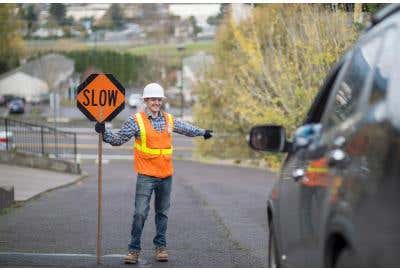Flagger Safety: Jobsite Hazards and How to Mitigate Them


On jobsites that perform road repairs, utility pole maintenance, and other duties on or near busy roadways, flaggers are employed to help control the flow of traffic, as a control to assist in keeping their team and passing drivers safe. But flaggers face unique hazards, making it crucial to follow proper flagger safety techniques each time they pick up the flag. Here, ClickSafety outlines the major dangers that flaggers face during the workday and offer some insights about how to mitigate them effectively.
The Two Main Flagger Hazards
An important task of flaggers is to promote the safety of their team and the awareness of the drivers around them. No matter where their job takes them, flaggers from all around the country face two major hazards during the workday. These include:
High-Speed Traffic
When cars are traveling at high speeds, it takes a significant amount of time to bring them to a full stop. For example, a car traveling at 60 miles per hour will need an estimated 400 feet to completely stop.
When working near high-speed traffic like this, driver inattention or any number of other factors can quickly result in an accident. In cases like these, the flaggers who work closest to this traffic can be severely harmed, making it crucial to implement proper flagger safety strategies.
Angry or Aggressive Drivers
When roadwork causes severe delays or drivers are impatient to get to their destinations, tensions can often reach a boiling point. In these cases, angry or aggressive drivers may try to drive around flaggers or even harm them directly.
Mitigating Flagger Hazards
In the face of these dangerous workplace hazards, organizations like the Occupational Safety and Health Administration (OSHA) and others have developed safety measures for flaggers to put into place. These include the following:
- Wear high-visibility clothing: To ensure that drivers can see them from far away, sources recommend flaggers wear red, orange, yellow, or green vests during the day and retro-reflective vests at night.
- Wear protective equipment: In case an accident occurs or roadway debris strikes a flagger, they are encouraged to wear a hard hat, a long-sleeve shirt and pants, and other weather-appropriate gear.
- Plan an escape route: Flaggers are encouraged to plan an escape route in cases of emergency. For example, in cases where inattentive drivers don’t brake soon enough or aggressive drivers express intent to harm, flaggers can quickly follow these routes to get to safety.
- Treat motorists with respect: By treating drivers with courtesy and not responding to angry outbursts or picking fights, flaggers can better ensure their safety on the jobsite. In cases where motorists are being obstinate, they should notify local law enforcement.
- Strategize your location: Flaggers should stand alone and in clear view on the shoulder of the road. This way, instructions will be clearer for drivers, and they will be better able to avoid the flaggers as they pass.
- Stay alert and focused: To stay as safe as possible, it is important for flaggers to remain alert and focused at all times. Since traffic moves fast, hazards can appear quickly. By staying aware of their surroundings, flaggers can identify them when they occur and prevent them successfully.
Learn More about Flagger Safety Today
Whether you work in the construction or industrial field, safety should always be your main priority. To help flaggers prepare, ClickSafety offers online safety courses and resources, including the Advanced Cal Flagger for Construction Course and Construction Work Zone Flagger Safety Toolbox Talk. To learn more about flagger safety or to get your entire team up to speed, contact us today.

